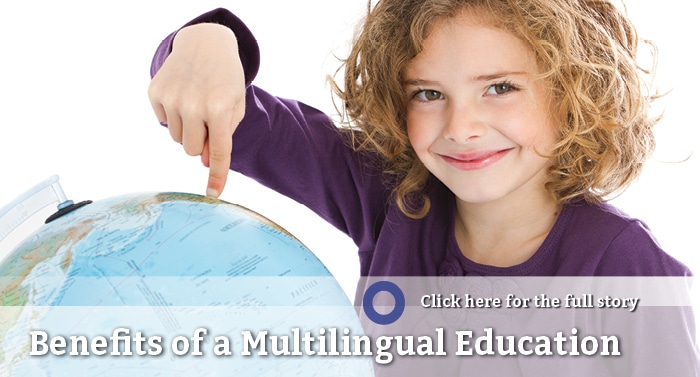By Sean Diana and Cortney Vaughan
As the United States becomes more diverse, and global economies intersect with the U.S. economy, language diversity is becoming more appreciated and sought after. Multilingual education – bilingualism and trilingualism are now seen as a benefit and a way for parents to give their children a cognitive and linguistic advantage. Bilingualism is increasing in the United States at such a fast rate that in 2015 more than 65.7 million people spoke more than one language. [1]
Early childhood programs that incorporate full language immersion models in their school provide a unique advantage to young learners. Full language immersion utilizes native speaking teachers speaking in their native language throughout the entirety of the school day. The full language immersion model provides students the most crucial piece to learning a second language: exposure.
In addition to exposure, early childhood programs who pair the full language immersion model with the four modes of language learning, provide early learners the best opportunity to learn a second or third language and achieve native fluency.
The Four Modes of Language Learning
There are four cornerstones of learning a language: Reading, Writing, Listening, and Speaking. These four modalities work in pairs across multiple contexts to support the child wholly within their language and literacy development.
Reading: Children who are read to daily using authentic language books and who have access to a multitude of books in the school library will be immersed in the new language through print.
Listening: Students who listen to authentic native teachers speak their language through full immersion and who have access to multilingual music will strengthen their skills in listening, understanding, and processing the new language.
Writing: Students who have daily opportunities to write and learn about the sounds of letters or characters, will eventually begin writing their own stories.
Speaking: Students who have the opportunity to speak to their teacher in their native language consistently throughout the day will strengthen their pronunciation skills.
In addition to choosing an early childhood program that utilizes the full language immersion model in correlation with the four modes of learning language – it is important your child receives early exposure to a second language.
Research including the Brain Plasticity theory have shown that the younger a person is when he or she is exposed to a new language, the more likely the child will acquire native pronunciation as well as proficiency in that language.
Research into sensitive periods, developmental windows of opportunity where a child learns specific concepts naturally, were researched following the introduction of language immersion in 1960, and concluded that:
“In the search to discover whether there is a “critical or sensitive period” (Lenneberg, 1967) for later-exposed bilingual or second language learning, scientists had first conducted behavioral experiments on bilinguals’ language proficiency, as a function of whether they were introduced to their other language earlier versus later in life. These behavioral studies consistently found that proficiency in the later-exposed bilingual and/or second language learners declined dramatically if learned after puberty, and not earlier (Johnson & Newport, 1989; McDonald 2000).”3
Early exposure to a second or third language was further proved vital when researchers found that:
“Early (before age 5) bilingual language exposure is optimal for dual language development and dual language mastery (Kovelman & Petitto, 2002). (2) Those bilingual children who were first raised monolingual from birth and who were then exposed to a new language between 2–9 years of age did achieve the morphological and syntactic fundamentals of the new language within their first year of exposure. However, we found that the rapid acquisition of new language fundamentals was possible only when extensive and systematic exposure to the new language occurred across multiple contexts.”4
Research has since supported the language immersion model for children as we have discovered:
“[That] children who learn a second language store that capacity, together with their native language, in one sector of the brain, while adult language learners store each new language learned in a separate area. This finding helps to explain why children who learn two languages develop the ability to speak both with native pronunciation and proficiency when provided adequate time. […].“[2]
Picking the “perfect fit” school for your little one(s) is an important task parents face. With varying philosophies and models, it is important to look into not only traditional school settings, but also out of the box schools to provide your child with opportunities they might not find in a traditional classroom. While many schools may offer supplementary language classes, finding a school that incorporates full language immersion will provide your child the exposure they need to achieve native fluency and build a skill that will support them for a lifetime.
Sean Diana is the founder of Amici Trilingual Montessori and Cortney Vaughan is the school’s director. Located in the community of Ahwatukee in Phoenix Arizona, the school teaches students using the Montessori philosophy and full language immersion. Learn more by visiting amicimontessori.org
[1] https://www.languagemagazine.com/2016/12/09/bilingualism-steep-rise-u-s/
[2] http://web.pdx.edu/~fischerw/courses/advanced/methods_docs/pdf_doc/wbf_collection/0401_0450/0405_FLA_2006_Kennedy_Brain.pdf

